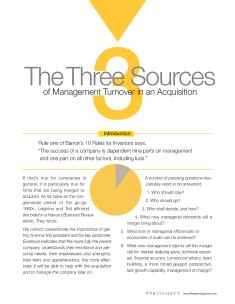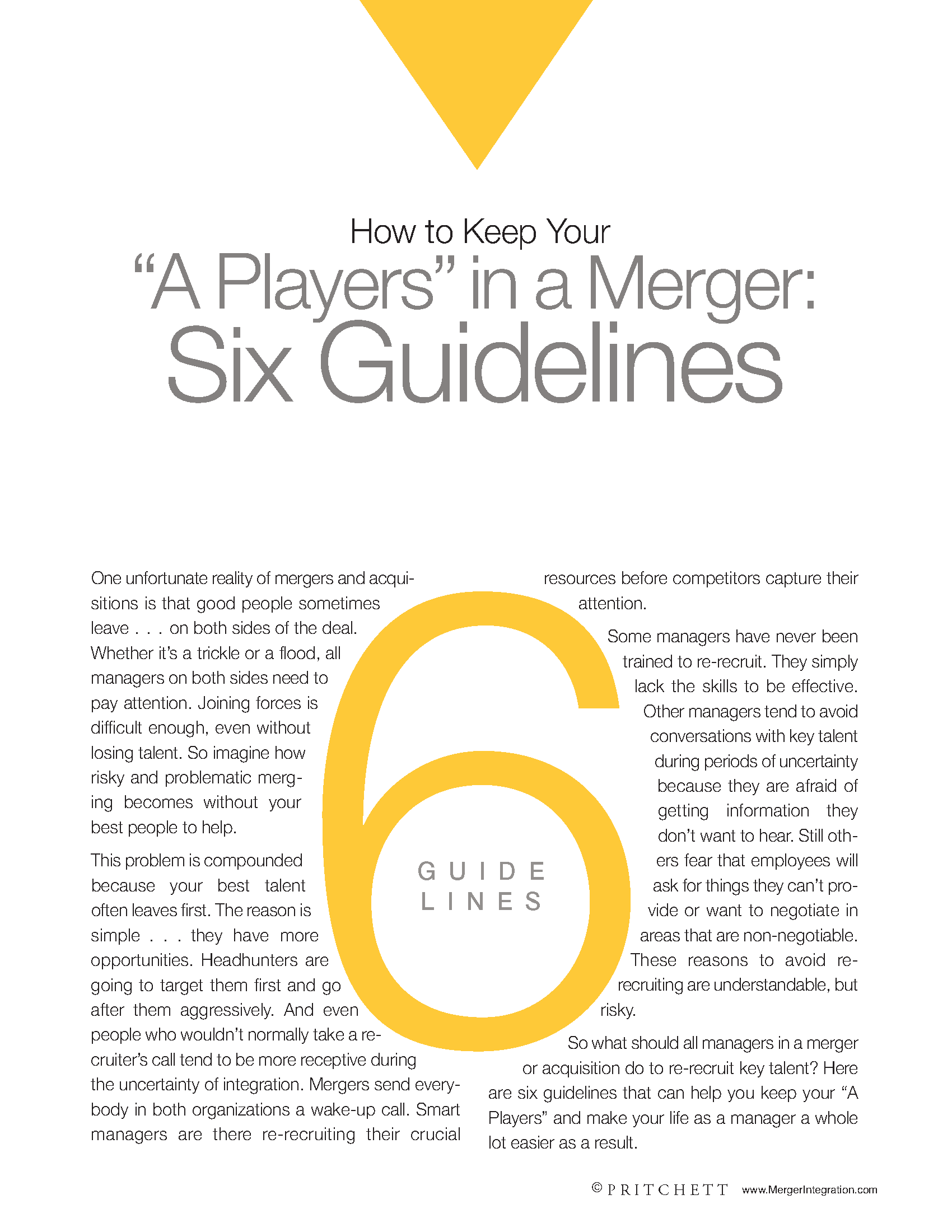Rule one of Barron’s 10 Rules for Investors says, “The success of a company is dependent nine parts on management and one part on all other factors, including luck.”
If that’s true for companies in general, it is particularly true for firms that are being merged or acquired. As far back as the conglomerate period of the go-go 1960s, Leighton and Tod affirmed this belief in a Harvard Business Review article. They wrote:
We cannot overestimate the importance of getting to know the president and his key personnel. Evidence indicates that the more fully the parent company understands their emotional and personal, needs their weaknesses and strengths, their fears and apprehensions, the more effectively it will be able to help with the acquisition and to manage the company later on.
A number of pressing questions desperately need to be answered:
- Who should stay?
- Who should go?
- Who shall decide, and how?
- What new managerial demands will a merger bring about?
- What sort of managerial efficiencies or economies of scale can be achieved?
- What new management talents will the merger call for: market-realizing savvy, technical expertise, financial acumen, turnaround artistry, team building, a more broad-gauged perspective, fast-growth capability, management of change?
- What kind of management potential has been acquired? And what does it imply for long-range personnel planning?
- How can the newly acquired retinue of managers best be managed and motivated?
- How does one play to their strengths and shore up their weaknesses?
- Will the right personal chemistry and compatibility be there? Can I work with these people?
The answers to some of these questions, of course, hinge on other issues that must be addressed, such as the following:
- To what extent will the organizations be merged?
- Will the acquisition be run on a centralized basis or be allowed extensive operating autonomy?
- What control policies and procedures will be implemented to guide the subsidiary?
- What operations or functions are overlapping—how will the parent company ascertain which facilities, departments, and so on, will be abolished, expanded, or left as they are?
Management should establish well-defined criteria by which to evaluate the human resource aspects of the merger. Parent company objectives must be identified as a preliminary step and conclusions drawn regarding how these objectives can best be achieved.
Assuming that the acquiring firm has developed a strategic road map that addresses the integration issues mentioned above, the next order of business is to make a thorough assessment of key management and technical talent that initially comes with a new acquisition. Part of this appraisal should be a determination of how much of this talent could be retained.
Bailouts
One of the most likely bailout points is in the top management ranks. Key executives who fought the merger/acquisition often feel that their relationship with the parent company has been strained beyond repair and that they have too many fences to mend. Feeling that their career is on shaky ground, and without any quick and convincing messages to the contrary from top management in the parent company, they bolt.
The acquirer is frequently taken aback by this turn of events. Parent company executives may believe the relationship is developing quite well and think they have made it plain that they bear no residual ill will. In fact, parent company management sometimes assumes it has done more than is necessary to prevent key managers in the target firm from jumping ship. But assumptions can be extremely costly when dealing with acquisitions, particularly when they lead to vacancies in some of the most critical positions.
Another source of bailouts would be the disgruntled leaders who see themselves being layered away from the top of the power structure so that they suffer a loss of authority or stature. They leave of their own volition because they dislike new reporting relationships that place them further from the top person. Sometimes, though, they jump to conclusions and part company on the basis of false rumors or their own misperceptions. In other instances, the acquirer simply fails to do an adequate selling job vis-a’-vis how the new organization structure will still offer substantial challenge and, perhaps in the long run, even more career potential.
It should be obvious that these bailout candidates need their egos stroked. They need more attention, encouragement, and assurance of their value to the company than they are getting in many instances. The irony is that if they do leave and have to be replaced, the acquirer will end up having to spend much more time and likely quite a bit more money replacing them and bringing the new hires up to speed. Moreover, even when that has been accomplished, the company often has not fully replaced what the departing executives took in terms of technical knowledge, company insights, rapport with the workforce or customers, and so on.
Some people turn in their keys and credit cards in the wake of a merger even though their job is secure and they are held in high favor by the parent organization. These departures occur as the incumbents see storm clouds on the horizon regarding new operating styles or management philosophies likely to be imposed by the acquirer.
Here again, some of these people leave on impulse. Taking a fatalistic view of how they will be handled by the new owner, they clear out their desks and leave. Ordinarily, they rationalize their behavior as something that grows out of philosophical differences regarding how they feel business should be conducted. But underneath this veneer may be more fundamental psychological forces—specifically, a fear of not measuring up, concern about having an inability to meet the new standards, a reluctance to admit that they actually don’t know how to do things the parent company way.
So again, ego-related issues begin to create merger problems. But the parent company is not likely to hear a key person from the acquired firm say, “Listen, I’m scared. I’m afraid I’m going to look foolish or outclassed.” Pride gets in the way, and instead of a cry for help, one hears complaints and criticism aimed at the new owner. So often, people pick their words not to reveal who they really are and what they truly think but to conceal their fears and protect themselves. Parent company management often fails to perceive the dynamics at work. The needed support, encouragement, and coaching are never provided, and the person suffering the insecurities finds an escape route.
Granted, some executives who leave because they do not like the acquirer’s operating style or philosophy are extremely confident, secure individuals. They harbor zero concerns about their own ability to measure up. They simply can’t accept how the company is supposed to be run in the post-merger setup. Parent company efforts to keep these people on board should include a concerted communication effort. Pains should be taken to explain the new approach or methodologies—for example, the justification, the benefits, the specifics regarding how the system will work, and the important role these managers will play in the scheme of things. Naturally, some will still leave. But some will stay and adapt well, and both they and the company will benefit.
Some key players jump ship because they cannot (or will not) endure the uncertainty, ambiguity, and stress so characteristic in a new acquisition. Other people leave because they can’t stand merger politics. The best way to hang on to this contingent of employees is to overcome the psychological shockwaves as quickly as possible and then get people oriented toward clear, definitive goals. These people want closure. They want to know where they stand, what’s expected of them, and who they will be dealing with in the months to come. The sooner this can be laid out for them, the more likely they are to decide to remain with the firm, settle down, and resume their prior level of productivity
Executives who have been given “golden parachutes” make unusually good bailout material. Likewise, the nouveaux riches who sold their stock and can walk away with a bundle of money have a newfound freedom. Both sets of people frequently leave the scene simply because they have a variety of reasons for doing so, with only a few weak reasons for staying. Often the parent company bends over backwards to keep these people, only to end up with a top management team that isn’t hungry anymore. As the team’s drive and motivation slackens, so does the sense of urgency and the competitive spirit in the rest of the organization.
Finally, there are always people in an acquired firm who seek other job alternatives because they don’t like the new corporate direction that, at least in their opinion, the merger portends. For example, if an employee had plans of building his or her career with a small but growing retail firm and it is taken over by some large, stuffy, bureaucratic organization in a completely different industry, the individual may become a bailout because of the gloomy career future she or he foresees.
It is imperative that the parent company remember, though, that the best people probably find it easiest to leave. Those who possess the most talent will, in all probability, have the greatest number of alternatives, the most promising opportunities dangled before them. These people also will have the most hustle, the most personal initiative, so they won’t wait for opportunity to come knocking. And they are not afraid to seize it even if it means leaving familiar routines and comfortable surroundings. Certainly, they are not averse to leaving the destabilized atmosphere created by a merger.
Terminations
Insurgents and Obstructionists
In many merger situations, particularly the more adversarial takeovers, significant people in the acquired firm refuse to embrace the new order. They are either unwilling or unable to adapt to the new scheme of things. These people pose a problem on two counts. First, at a time when the organization needs facilitative influences, they are an obstruction. They get in the way of the needed changes, whether as a result of personal rigidity, lack of competence, or simply rebellion against the new owner. Second, they tend to become somewhat insurgent, infecting others with their negativism and resistance to change. Typically, they rationalize away their own inadequacies and project blame onto the parent company, accusing it of being responsible for the shortcomings in their job performance. They fan the flames of unrest, sometimes subtly and surreptitiously, sometimes blatantly. Particularly when in positions of authority or high visibility, they easily provoke greater discontent among other personnel.
Sometimes, of course, this undesirable behavior can be eliminated if the parent company (1) gets an accurate fix on who these people are and (2) confronts the problem head-on. But while some individuals have the ability and the willingness to change their attitudes and upgrade their work behavior, others do not.
Those people who do not succeed in getting on board should be separated from the organization. When they are indulged, allowed second or third chances, or merely given a light slap on the wrist, the parent company is essentially reinforcing the wrong behavior. Much better for the acquirer to set definite limits, communicate those boundaries in a clear and distinct fashion, and then enforce them firmly. This can send an important, unmistakable message to bystanders in the acquired firm who are watching attentively to see how the new management deals with personnel problems. Not only is it important for the success of the merger that the insurgents be terminated, it is also essential that the early precedents be designed to communicate clearly the new rules or standards by which top management plans to operate.
Executives in the acquiring firm lose credibility and respect when they drag their feet in making needed terminations. Management can be firm without being ruthless, equitable without being indulgent. Such an approach is in the long-run best interest of both the organization and the employee.
Staffing Duplications
The merging of two organizations routinely creates superfluous or excess personnel as a result of the consolidation of departments, integration of functions, or elimination of certain work groups. When two companies with duplicate functions merge, obviously there are redundancies that cannot be justified from a payroll standpoint. Further, mergers are frequently sought for the economies of scale they permit, and this means that in all likelihood some people will need to be dismissed.
Ordinarily when such reorganizations are contemplated, the parent company should move expeditiously to make the realignments and complete the merger process. To begin with, people can usually sense when such a consolidation is likely, and organizational momentum suffers badly until that process has been finalized. The more quickly top management moves in, making its restructuring and staffing decisions, the more it gets to exercise its preferred options. In the early stages, the best performers are still in the picture and therefore can more likely be given key assignments sufficiently challenging to keep them with the company. On the other hand, if the reorganization and reassignments come too slowly, the acquisition frequently stalls out, and good people go elsewhere to seek their fortunes.
Nonperformers
When the acquisition of a firm is carried out as a financial salvage operation, there typically is strong logic in favor of replacing some key people. The executives who carried the organization into red ink and who are seen as part of the problem instead of the solution are obvious candidates for termination. To leave these executives at the helm may run the risk of sabotaging any turnaround effort the acquirer attempts. The tough question, and one that deserves a well-researched answer, is, “Which incumbents should be retained for the contribution they could make to the ailing firm’s rehabilitation?”
Even those acquired firms that are financially sturdy will often have selected personnel who, for one reason or another, are not performing up to par. Perhaps they were indulged by the company for one reason or another, managed to escape notice somehow, or led a charmed life that allowed them to survive without really earning their keep. Under the more scrutinizing, nonpartisan eye of management in the new parent company, however, these people will be found wanting and should be encouraged to leave.
There are several good reasons for moving promptly to separate these employees. First, if they are not contributing that much, better to let them go and remove that drain on the payroll. Second, this action communicates a worthwhile message to others throughout the acquisition to the effect that the new owner has little tolerance for nonperformance. This sort of termination gets the word across that mediocrity can be a risk to job security. A third argument supporting the idea of expeditiously terminating weak people is that such action generally is applauded by those in the acquired firm who are good performers. The capable people, those who are really productive, ordinarily will have grown quite weary of having to carry the load that should have been borne by others.
Thus, when the new owner steps forth purposefully to purge the acquired firm of weak people, he or she customarily meets with the approval of the real contributors. In fact, this should serve as a motivating event for contributors. It is related to the fourth reason for expeditiously terminating the incumbents who haven’t been measuring up as they should. Specifically, when lackluster performers are let go, that opens up slots that allow the promotion and reassignment of more promising personnel. This kind of housecleaning and reallocation of human resources is particularly appropriate in the merger/acquisition arena where people are expecting change.
Opportunities for Streamlining
Top management in the acquiring firm usually finds that just as there is a need to get rid of insurgents, redundant personnel, and nonperformers, there is also some fat that can be trimmed. Practically all organizations accrue a certain amount of excess baggage as years go by. It’s an insidious process, and something to which the target company grows accustomed. But the sharp eye of the acquirer should be able to ascertain where these opportunities for streamlining exist.
There may be people in the management ranks who are a manifestation of the Peter Principle—people who have “reached their level of incompetence” and are quite expendable. Perhaps in being kicked upstairs they have been made relatively harmless. But if they are in over their heads, and particularly if they are rather nonproductive, they should be viewed as candidates for termination. Again, the vacancies created may provide superb opportunities to promote up-and-comers who can revitalize the acquired firm.
There may be others on board who, though quite capable and even reasonably productive, have been given makeshift assignments that fall short of justifying their continuing existence on the company roster. Some of these folks may be worthy of reassignment or transfer, but at the very least their work role should be scrutinized and their contribution carefully weighed. If these people cannot be channeled along more productive paths, they too, should be dismissed.
Other incumbents may be identified who have ended up in assignments for which they are poorly cast. The post-merger environment can be an opportune time to correct these unsuitable appointments that have been tolerated too long. Some of these mismatches may indeed involve high-caliber talent that could be most beneficial to the acquired (or parent) firm if the people were reassigned. But this calls for careful assessment of the person as well as the organization’s needs, an appraisal process that should occur early in the post-merger scheme of things. If it is determined that these personnel are expendable, in all likelihood the ties should be severed as part of a global, systematic effort to make the acquired firm more lean and trim.
People Recruited Away from the Firm
When word begins to circulate that a company has been targeted for acquisition, it often pricks up the ears of corporate recruiters and executive search consultants. They know, at least implicitly, that the event will increase the likelihood that people within the firm to be acquired will be more approachable than before. The situation is viewed as “open season,” one of the easiest times to lure away technical specialists, key managers, and executives.
Mergers and acquisitions generally cause people to reassess their careers, examine their alternatives, and check out promising options.
In other words, they become much more amenable to putting themselves on the market, whereas under normal circumstances they might prefer to remain settled, steadfast, and secure in their jobs. These employees may not have looked at the employment ads for many years. Ordinarily, they might be inclined to dismiss any overtures another potential employer might send their way. But being acquired changes all that.
High-talent people, in particular, will often opt for immediate guarantees they can negotiate with a new employer rather than wait out the merger situation and gamble that their careers will be well served (or at least not damaged) by the acquisition of their firm. This is especially true when the parent organization has a bad reputation in the business world for its handling of acquisitions.
Those who are recruited away might never have become bailouts, much less terminations, but they still can become a part of management turnover statistics. When they leave, ordinarily they not only weaken the company, but also frequently end up strengthening the competition that has stepped in to take advantage of the situation.





